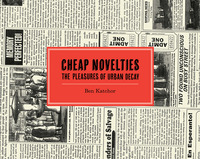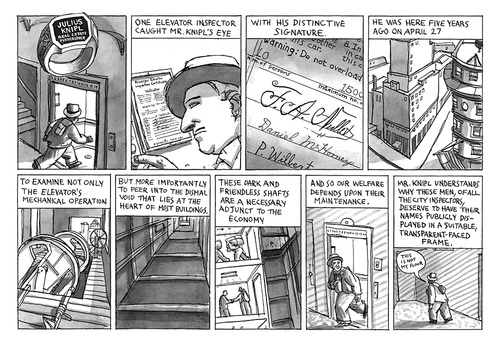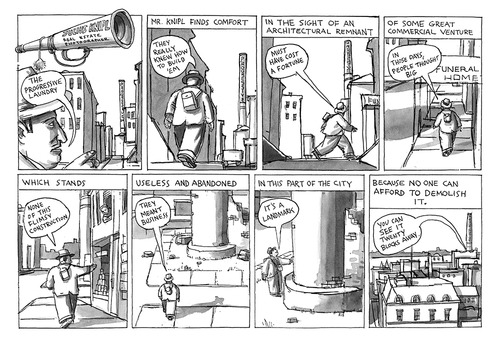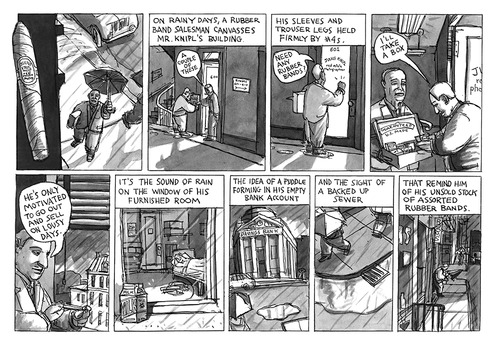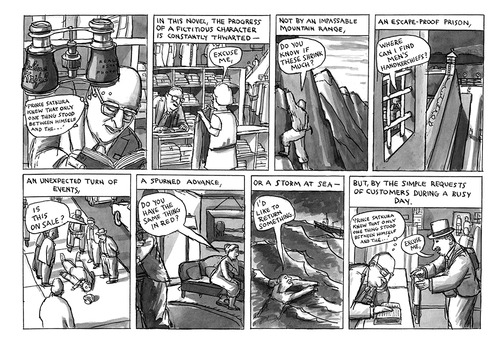Imagined Cities and Real Nostalgia: Revisiting Cheap Novelties With Ben Katchor
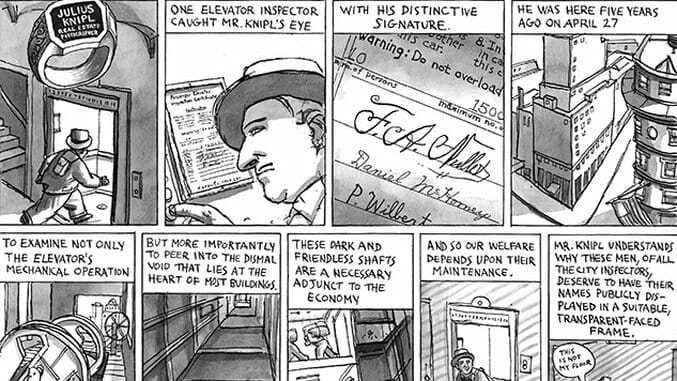
Cartoonist Ben Katchor’s distinctive comic strips tell the singular story of a surreal city and the people who live and work there. His recurring character, real estate photographer Julius Knipl, lies at the heart of several of Katchor’s books, including Cheap Novelties: The Pleasures of Urban Decay. Attempting to describe these strips isn’t easy: they broadcast on an exclusive frequency and, like the works of novelist Steven Millhauser, turn the odd minutiae of urban life into the stuff of strange and compelling narrative. Cheap Novelties funnels the passage of time and a cultural history rare for the medium.
In conversation, Katchor is often rueful about the state of the modern city, lamenting the ways in which businesses have given way to greater standardization. He’s also dryly funny—which, given how his strip’s punchlines sneak up on you, makes a lot of sense. In the following interview, Katchor discusses the new edition of Cheap Novelties out next week and how he continues to draw inspiration from the metropolises around him.![]()
Paste: How long has the new edition of Cheap Novelties been in the works?
Ben Katchor: The original one went out of print quite a while ago. Drawn & Quarterly approached me about reissuing it. So recently. It was the first book I did; it was a small Penguin paperback. And, like most books, it had its life on the shelf and then it was remaindered and disappeared. Actually, it’s the only book of mine that’s out of print. The other ones, somehow, have all stayed in print.

Cheap Novelties Interior Art by Ben Katchor
Paste: As someone who lives in New York, Cheap Novelties really captures the feeling of nostalgia for an older version of the city, and I feel like the strips have aged very well for that reason. Do you feel like that’s specific to New York City, or something about cities in general?
Katchor: The city in the strip is not identified as New York—it’s just an old post-industrial city, maybe on the East Coast. People who read it in Providence think it’s Providence, and people who read it in Chicago think it’s Chicago. It’s not identified as New York.
But the thing is, what made cities interesting was the variety of street life in a city. You could walk down a block and it was a catalog of every possible entrepreneurial invention. It was this endless discovery, when you used to go for a walk in the city. And I think that’s one of the things that drew people to live in cities. The mall-ing of cities, taking over most of the retail space with chain stores, that’s gone on since that strip was running. I don’t see that turning around.
That just makes it boring to take a walk. Forget about the fact that most of these companies don’t pay their employees and they’re selling horrible products—on top of it all, it makes it boring to take a walk in the city, because all you’re doing to discover is another Starbucks on the next corner. That’s getting worse. That’s just continuing, that trend.
Paste: Are there neighborhoods in different cities where you still enjoy being able to go out and take a walk?
-

-

-

-

-

-

-

-

-

-

-

-

-

-

-

-

-

-

-

-

-

-

-

-

-

-

-

-

-

-

-

-

-

-

-

-

-

-

-

-

